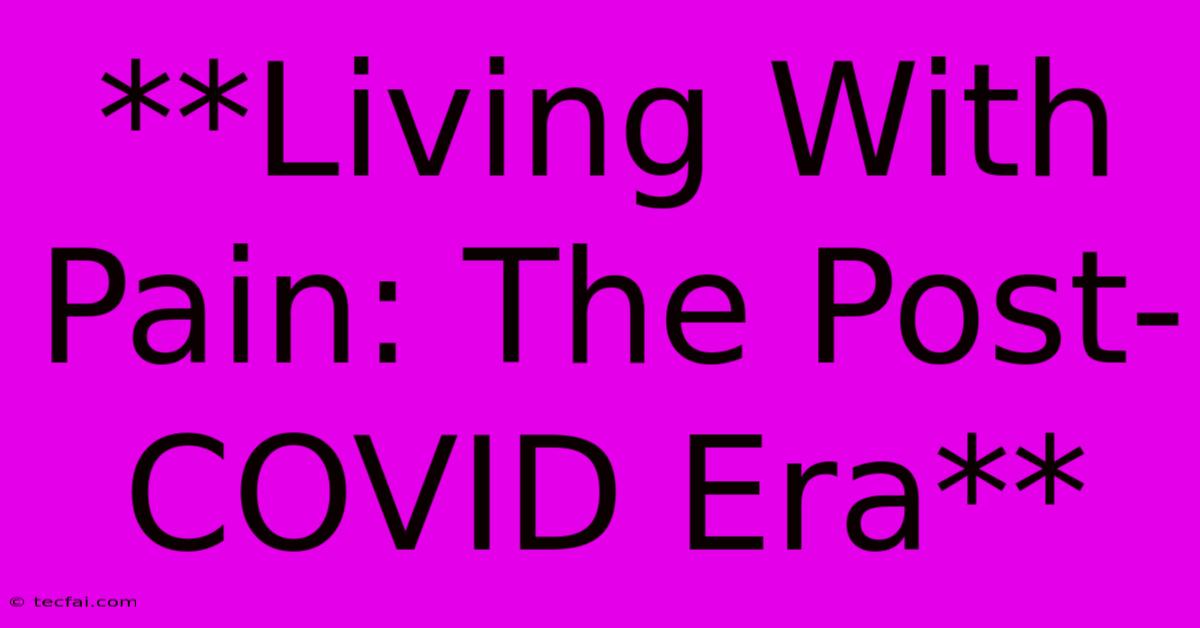**Living With Pain: The Post-COVID Era**

Discover more detailed and exciting information on our website. Click the link below to start your adventure: Visit Best Website tecfai.com. Don't miss out!
Table of Contents
Living With Pain: The Post-COVID Era
The COVID-19 pandemic has left an indelible mark on the world, and for many, the impact extends far beyond the initial infection. A growing number of people are experiencing long COVID, a condition characterized by persistent symptoms that can last for weeks, months, or even years after the initial infection. One of the most common and debilitating symptoms of long COVID is pain, which can manifest in various forms and locations throughout the body. This article will delve into the complex relationship between COVID-19 and chronic pain, exploring the challenges and potential solutions for individuals navigating this new reality.
Understanding the Link Between COVID-19 and Pain
The exact mechanisms by which COVID-19 can lead to chronic pain are still being investigated, but several theories have emerged:
- Inflammation: The virus itself can trigger widespread inflammation throughout the body, which may contribute to pain.
- Neurological Damage: COVID-19 has been linked to damage to the nervous system, including the peripheral nerves responsible for transmitting pain signals.
- Autoimmune Response: In some cases, the body's immune system may become dysregulated after COVID-19, attacking healthy tissues and causing pain.
- Psychological Factors: The stress, anxiety, and disruption caused by the pandemic can also contribute to pain perception and exacerbate existing pain conditions.
The Impact of Post-COVID Pain
Living with persistent pain can significantly impact an individual's quality of life, affecting their:
- Physical Function: Pain can limit mobility, making everyday activities challenging and reducing overall physical function.
- Mental Health: Chronic pain can lead to depression, anxiety, and sleep disturbances.
- Social Interactions: Pain can make it difficult to participate in social activities and maintain relationships.
- Work Productivity: Pain can interfere with work performance, leading to absenteeism and reduced productivity.
Managing Pain in the Post-COVID Era
While there is no one-size-fits-all solution for post-COVID pain, a multidisciplinary approach can be effective:
- Medical Evaluation: See a doctor to rule out other potential causes of pain and discuss appropriate treatment options.
- Pain Management Therapies: Pain management specialists can provide a variety of therapies, including medication, physical therapy, occupational therapy, and psychological counseling.
- Lifestyle Modifications: Lifestyle changes such as exercise, healthy diet, stress management techniques, and adequate sleep can play a significant role in pain management.
- Support Groups: Connecting with others who are experiencing similar challenges can provide valuable support and resources.
Research and Advocacy: The Path Forward
While more research is needed to fully understand the long-term effects of COVID-19 on pain, ongoing studies are providing valuable insights into the mechanisms underlying this complex condition. Advocacy groups are also playing a crucial role in raising awareness and promoting access to resources for individuals living with post-COVID pain.
Living with pain in the post-COVID era can be a challenging experience, but with proper medical care, support, and a proactive approach, individuals can find ways to manage their pain and improve their overall quality of life.

Thank you for visiting our website wich cover about **Living With Pain: The Post-COVID Era**. We hope the information provided has been useful to you. Feel free to contact us if you have any questions or need further assistance. See you next time and dont miss to bookmark.
Featured Posts
-
Malema Meer Eff Lede Kan Volg Mpofu
Nov 07, 2024
-
Walzs Vp Hopes Dashed By Trump Victory
Nov 07, 2024
-
Honig Reacts Jack Smiths Potential Result
Nov 07, 2024
-
Mavericks Vs Bulls Live Oras Mga Tsansa
Nov 07, 2024
-
Milan Cracks Down On Arsenal Fans
Nov 07, 2024
